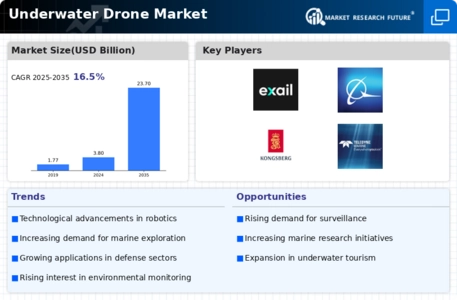Market Analysis
In-depth Analysis of Underwater Drone Market Industry Landscape
Global military spending increased by 1.1% in 2017, reaching around USD 1.74 trillion, as per the Stockholm International Peace Research Institute. Key contributors to this rise were China, Saudi Arabia, and India, with spending increases of 5.6%, 9.2%, and 5.5%, respectively. India surpassed the UK to become the fifth-largest defense spender globally. While there was a minor dip, the US is expected to significantly boost military spending in the next two years, prioritizing the modernization of conventional and nuclear weapons. Other nations are also investing in advanced technologies to expand and enhance their armed forces' capabilities. Ongoing conflicts, territorial disputes, and counterterrorism efforts are prompting governments to strengthen their defense capabilities, fueling growth in the defense equipment industry, including ROVs (Remotely Operated Vehicles). ROVs play a crucial role in ensuring national safety, evolving from initial uses in underwater observations to becoming essential for security in light of global political tensions. Advanced ROVs, equipped for improved thrust, find applications in naval operations, research, reconnaissance, and mine countermeasures during emergencies. For instance, the ECA Group delivered mine identification and destruction systems (MIDS) to an Asian navy, featuring K-STER I identification ROVs and K-STER C neutralization ROVs in September 2018. The increasing focus on ROVs in defense and rising military spending are expected to drive market growth in the coming years. As military spending continues to rise globally, governments are increasingly emphasizing the need for advanced technologies to bolster their defense capabilities. The Middle East and Africa are witnessing ongoing conflicts, while Asia-Pacific is grappling with territorial disputes between nations. In the Americas, efforts to counter drug cartels add to the growing demand for robust defense systems.
In this landscape, Remotely Operated Vehicles (ROVs) have emerged as pivotal assets in ensuring national security. Originally utilized for underwater observations and weapon recovery, the role of ROVs has evolved to meet the demands of contemporary geopolitical challenges. The heightened focus on maritime security underscores the importance of ROVs in executing secure underwater missions.
Modern ROVs, equipped with enhanced thrust capabilities, prove invaluable in naval operations. Defense organizations leverage this technology for a spectrum of applications, including research, reconnaissance, and mine countermeasures, responding promptly to diverse emergency scenarios.
A notable example is the delivery of mine identification and destruction systems (MIDS) by the ECA Group to an Asian navy. These systems incorporate K-STER I identification ROVs and K-STER C neutralization ROVs, showcasing the adaptability and effectiveness of ROVs in safeguarding maritime territories.
The integration of ROVs into military strategies aligns with the broader trend of military modernization, where nations invest in cutting-edge technologies to maintain a strategic edge. The evolving nature of conflicts and security threats necessitates innovative solutions, and ROVs have proven to be versatile tools in this context.
As defense organizations worldwide allocate significant portions of their budgets to military advancements, the demand for sophisticated equipment, including ROVs, is set to grow. The market's trajectory indicates a pivotal role for ROVs in shaping the future of defense operations, offering a blend of technological prowess and strategic versatility for safeguarding national interests.








Leave a Comment